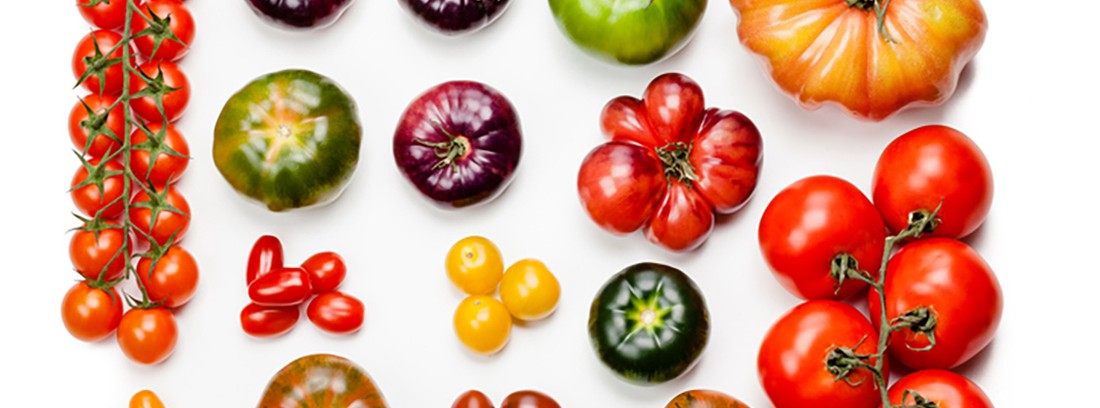Tomato, tasty and nutritious

Low calorie tomato, very antioxidant
Tomato is a food that provides us with very few calories since most of its content is water. A medium-sized ripe tomato, between 125 and 150 grams, provides about 25 Kcal. The contribution of nutrients is mainly based on rapid absorption, what we know as sugars.
It also provides us with a small amount of protein. At the micronutrient level, it is worth highlighting its lycopene content, a component with interesting antioxidant properties that are being studied in order to find a relationship between its intake and certain types of cancer. Regarding minerals, tomato It provides us with potassium and phosphorus and in terms of vitamins, compounds with provitamin A activity and, to a lesser extent, vitamin B1, B3 and E.
How to take it
Tomatoes in juice, in gazpacho and salads, in stir-fries and stews, in sauces such as Neapolitan, pink sauce or ketchup, in sandwiches and skewers, fillings, in jam, on toast or combined with salty foods, etc.
A CURIOSITY ABOUT TOMATO
The tomato is a climacteric fruit, which means that it is capable of ripening once harvested. This is due to its ability to generate ethylene, a gas necessary for vegetable maturation. Thus, if we keep the tomatoes in a closed plastic bag, we will be favoring a more accelerated ripening.
Who is it good for and who is not?
Tomato is a vegetable that can go well in most cases, also thanks to the fact that it enjoys great versatility in its preparations.
It is recommended for:
- . The low caloric content of tomato makes it ideal to be part of weight loss diets, either in salads where it manages to satisfy us with few calories, or in tomato-based sauces that will undoubtedly be less caloric than others with cream, cream of milk or oil.
- . The amount of fiber and water that it provides us will promote intestinal transit.
- Due to its potassium content and low sodium intake, it enhances renal excretion and fluid elimination.
- Strengthening of the immune system and prevention of cellular oxidation. The vitamin content of tomato, especially vitamin C and carotenoids such as lycopene, gives it beneficial properties at the immune system level and as an antioxidant.
It is not suitable in case:
- People with a tendency to ingestion of amines. The DAO diamine oxidase enzyme is responsible for metabolizing amines such as tyramine present in tomatoes. Some people suffer from a deficiency of this enzyme and amines accumulate in the body causing different disorders, among which we find migraine.
Buying and conservation advice
When buying a tomato The first thing we have to take into account is the purpose for which we buy it. For salad, for juice or sauce, for cooking, for spreading bread ... In any of the cases we will reject beaten specimens, with moldy parts or discolorations. In addition, and depending on the use that we are going to give it, we will see that a salad tomato is firm, has a greenish and reddish tone and that it feels heavy since it will give us an idea of its meatiness. Tomatoes for cooking should be softer to the touch but also meaty and juicy.
To preserve them, it is preferable to place them in the lower area of the refrigerator Although if they are not yet ripe we can reserve them in a cool, dry place and protected from light. If we want to force their maturation, we will keep them in a knotted plastic bag. They can also be preserved for long periods by making homemade preserves, jams and even freezing them after previous blanching and peeling.
REMEMBER THATů
Lycopene is a natural colorant, specifically a carotenoid that confers red or reddish color to different fruits and vegetables and is abundant in tomatoes. In addition, we know that its bioavailability increases when we cook it. Antioxidant capacity is attributed to this dye and therefore the relationship between its consumption and different pathologies, especially oncological ones, is being studied. There is still not enough evidence to make specific determinations but lycopene seems to act as a preventive against the,, ovaries, pancreas and prostate. It also appears to be effective in treating oral leukoplakia and human papillomavirus. And there are contradictory results regarding the effectiveness in preventing cardiovascular diseases.
THE RECIPE
Tomatoes stuffed with tuna and anchovies
- 6 large ripe tomatoes
- 2 onions and 2 cloves of garlic
- 100 g of breadcrumbs
- 100 g of tuna
- 6 anchovy fillets
- Olives to taste
- To season: parsley and oregano, grated cheese and olive oil
preparation:
Empty the tomatoes by initially cutting a slice from the top and then extracting the pulp, taking care not to pierce the tomato. Discard the seeds and chop the pulp. Sauté the garlic and onion previously chopped in a pan over low heat. When it is transparent, add the chopped tuna and crumble it. Once it is cooked, remove the pan from the heat and add the breadcrumbs and anchovies, olives and herbs, all after having finely chopped it. Mix well and fill the tomatoes with a spoon. Place the stuffed tomatoes in a baking dish and sprinkle them with cheese and drizzle with the tablespoon of olive oil. Cook the tomatoes at 180ºC for about 25 minutes or until they are soft. Wait about 5 minutes before serving.
- Season: its best time is from June-July to September-October.
- Benefits: low caloric intake, source of fiber, minerals and antioxidant vitamins.
- Ideal in: diets to lose weight, constipation, and to strengthen the immune system.
(Updated at Apr 14 / 2024)